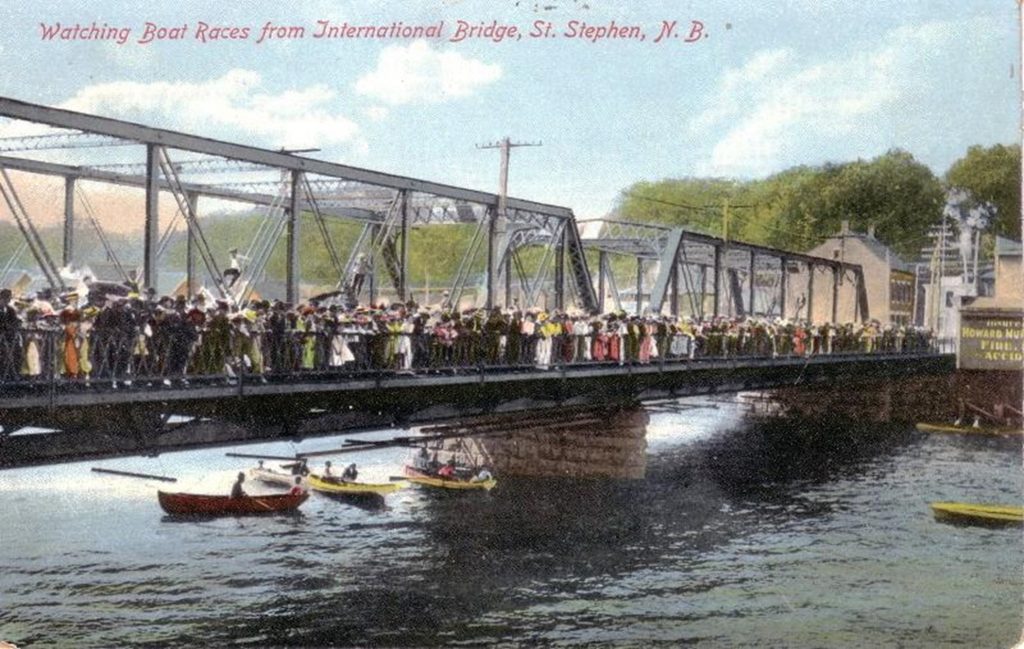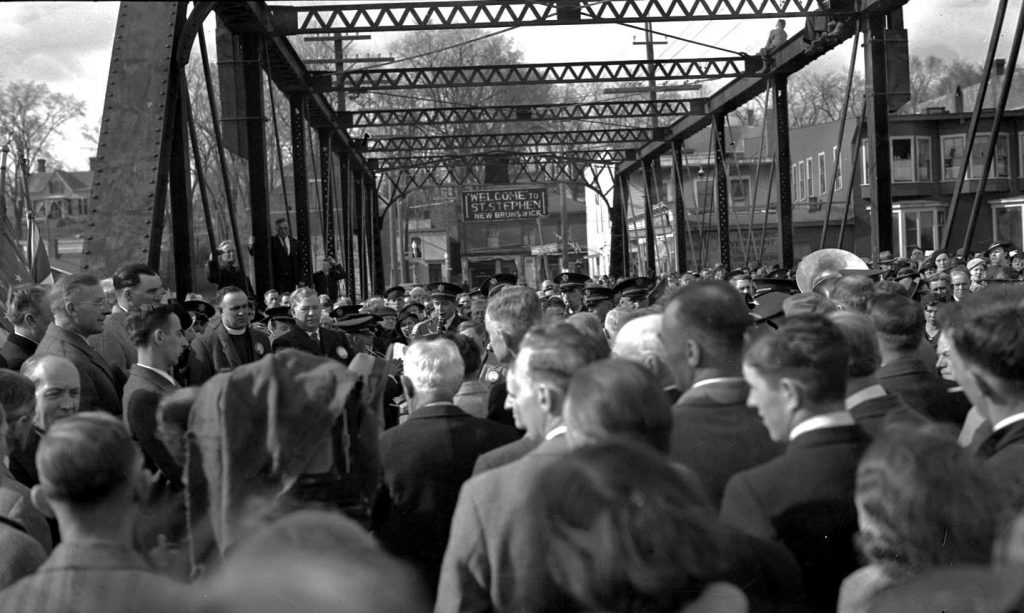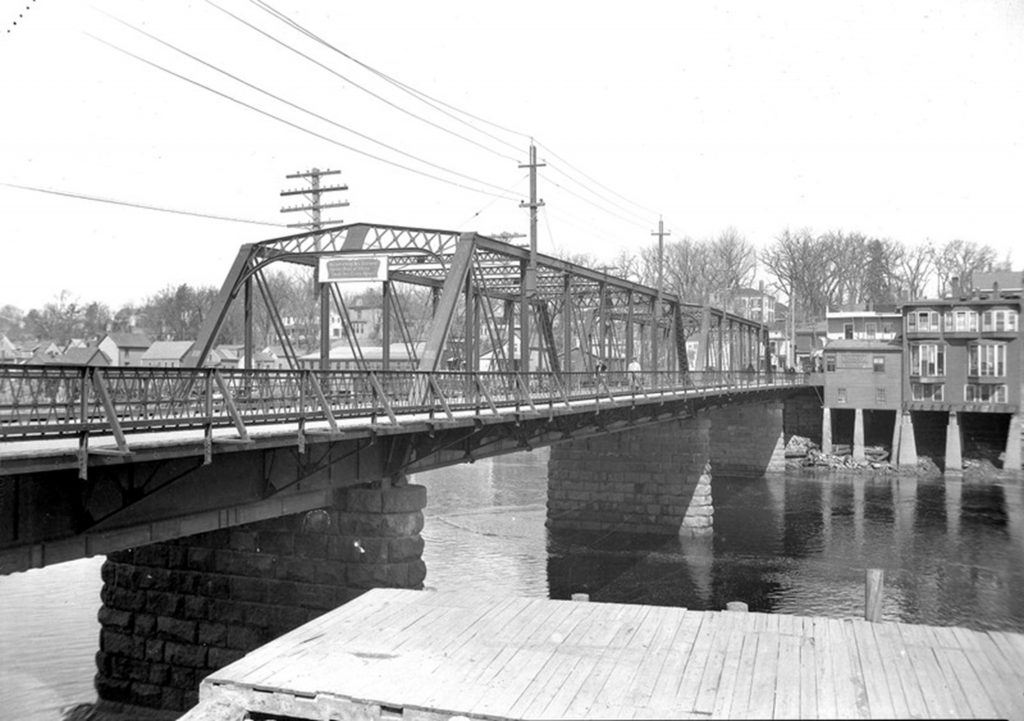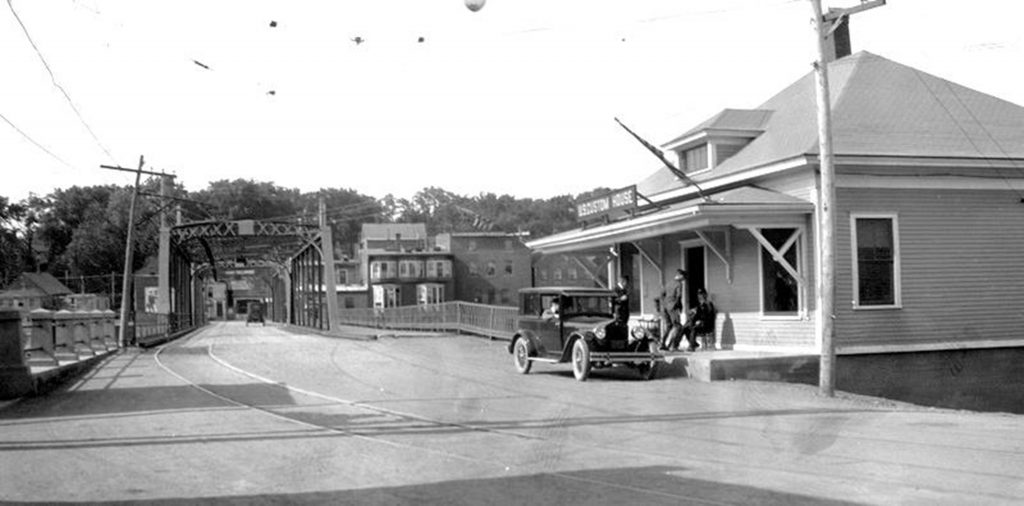We came across an article recently written by Sam Saunders, well known Calais historian and raconteur, which mentioned what Sam called the “Ole Steel Bridge” at Ferry Point, the main bridge connecting Calais and St. Stephen and how the local kids put the bridge to good use in the summer. It was all good, healthy fun unless you were from “away” and didn’t appreciate the hazards.


The old steel bridge between Calais and St. Stephen was built in 1843 and replaced in 1956. In both photos above the Canadian side is to the right. In the intervening years the bridge was the site of many ceremonies, celebrations, dedications and other events when crowds from both sides of the border crowded the narrow sidewalk and often spill over onto the bridge. For many years there were annual events on the river such as the boat races shown above. We can’t date the photos accurately but the second appears to show a number of boats powered by something other than sails or shoulders. We do know the first motorboat on the river was introduced by Allie McAllister of St. Stephen in 1903, so the photo must be after that date.

These events were always international in nature, displaying the tight bond between Calais and St. Stephen. We have not been able to determine what was going on in the photo above but it was very common for the bridge to be packed with people for ceremonies and dedications before 9-11 which, sadly, seems to have fundamentally changed the relationship between the two towns.
However the bridge was much more than a great location for handshakes and boring speeches. In the summer it was where kids from both sides of the border jumped into the town pool which in those days was the St. Croix River. Sam Saunders mentions “swimming off the bridge” in his reminiscences of Calais, and Frank Beckett says he learned to swim in the river just above the bridge. We have several photos of kids swimming in the river and a few of young boys skinny dipping in the river, their clothes on a nearby rock .


For most kids, a leap from the bridge rail into the river was quite enough to show they weren’t “scaredy-cats” and presuming the tide was right wouldn’t have been particularly dangerous for a decent swimmer; but, there were many who found such a short leap no challenge at all. These daredevils would climb the steel girders and dive off the top of the bridge which, as you can see above, required that the diver clear the railing below. As far as we know no one drowned or was injured while diving off the bridge, but there was another danger which led to tragedy in 1937. In August 1937 the Earl Taylor Revue came to Calais to play the State Theatre. The afternoon before their performance being quite warm, some of the players went for a swim in the river. The St. Croix Courier reported as follows:
Frank Sheaffer, a dancer with the Earl Taylor Revue which was to play the State Theatre in Calais yesterday, met almost instantaneous death by electrocution Tuesday evening when he grasped a high tension wire while standing atop the steel span of the Ferry Point Bridge. With his brother Charles and another member of the show, Frank Taylor, he had been swimming in the St. Croix River and diving from the top of the bridge. According to the stories of eyewitnesses, Sheaffer ignored the shouted warnings of several bystanders to “be careful of the wires”. After making one dive from the top of the bridge without accident, he climbed back up the second time with his brother, the two intending to dive together………
The locals of course knew well the hazard of the electric wires running across the river over the top of the bridge. These wires can be easily seen in the photos above, but the boy from away did not apprehend the danger and didn’t take the warnings of the spectators seriously. It is unlikely his death curtailed the use of the bridge as a diving platform because Sam Saunders recounts the legend of Roy “Guts” Tracy for whom even a dive off the top of the bridge’s span was child’s play.
“The higher ups in the City used to swim off the Ole International Bridge, or lean on the railing watching. The big event was when Roy ‘Guts’ Tracy would climb to the roof of the tallest building, just below the Canadian Customs and get ready to make his swan dive. Word would go out: “‘Guts’ is going to dive!” and traffic would stop and the people would crowd six rows deep on that bridge. Ole Guts, he’d be up there flexing his muscles, and taking a few dry runs to the edge of the roof, then someone would signal the time was ripe, and a step and a hop to the edge of the roof and off in the air he’d be, with his arms out like wings, he’d float there like a big assed bird with the most beautiful swan dive I’ve ever seen. Everyone would OOH and OOH till he hit the water and resurfaced, then the shouts and cheers would go up, while Guts, breast stroked it back to the wharf. I’ll tell you it took some kind of ‘Guts’ to perform that.”
The building “Guts” used for his swan dive can be seen in the photos above. We believe it is still there just to the left of the porch roof on the U.S. Customs building. In those days customs was on the downriver side of the bridge. The new customs house was not built until 1935.
Times have certainly changed since the days of the “Ole Steel Bridge”. Imagine if this bridge still spanned the river and a group of kids today clambered up the girders on a hot summer day for a leap into the river. Likely the bridge would be crowded but not with spectators but rather with emergency, homeland security and local law enforcement vehicles. Poor “Guts” wouldn’t know in which direction to swim to avoid apprehension.
